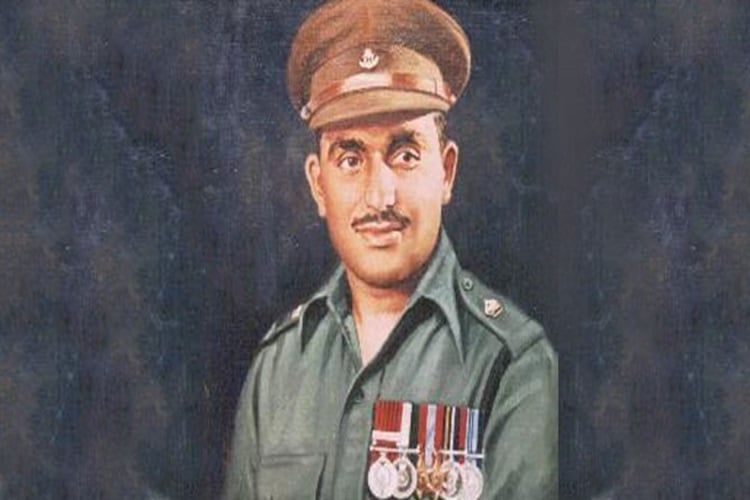Discover the Story of Rama Raghoba Rane

Rama Raghoba Rane (26 June 1918 – 11 July 1994) was a distinguished military officer and a recipient of the Param Vir Chakra, India’s highest military decoration for valor.
Early Life And Education
Rama Raghoba Rane, a distinguished figure in Indian military history, was born on June 26, 1918, in the village of Chendia, located in the Karwar district of Karnataka, India. He hailed from a Konkani speaking Maratha family and was the son of Raghoba P. Rane, a police constable. His early life was marked by frequent relocations due to his father’s transferable job, which led to a somewhat disrupted education mostly in district schools. Despite these challenges, Rane’s formative years were influenced by the Non-Cooperation Movement, which played a pivotal role in India’s struggle for independence from British rule. This exposure to the freedom movement at a young age left a lasting impression on him and shaped his future endeavors.
Career And Achievements
Major Rama Raghoba Rane military career began in the British Indian Army during World War II and continued post-independence. He was commissioned into the Bombay Sappers, a regiment of the Corps of Engineers in the Indian Army, on December 15, 1947. During the Indo-Pakistani War of 1947, Major Rane played a pivotal role in the capture of Rajouri, clearing roadblocks and minefields under heavy enemy fire, which facilitated the advance of Indian forces. For his extraordinary bravery and leadership, he was awarded the Param Vir Chakra, India’s highest military decoration, on April 8, 1948, becoming the first living recipient of this honor. His service, marked by exceptional gallantry, earned him five mentions in dispatches and a commendation by the Chief of Army Staff. After a commendable 28 years of service, Major Rane retired from the Indian Army in 1968. His legacy continues to inspire, embodying the values of courage and dedication to duty.
Notable Events And Milestones
Major Rama Raghoba Rane joined the Bombay Engineering Group as a Sepoy. His exceptional performance during training earned him the ‘Best Recruit’ trophy and the Commandant’s Cane. Rane’s valor during the Indo-Pakistan War of 1947-48 was pivotal in the capture of the Rajauri District of Kashmir, for which he was awarded the Param Vir Chakra, India’s highest military decoration for valor.
Rane’s contributions extended beyond the battlefield. His leadership and courage inspired his men and set an example for future generations of soldiers. He was mentioned in dispatches five times, reflecting his consistent bravery and dedication to duty. After retiring as a Major in 1968, Rane’s legacy continued to influence the Indian Army and society at large. His actions during the war are commemorated in military history and serve as a testament to his indomitable spirit and unwavering commitment to his nation. Rane’s impact on history is profound. His story is a reminder of the sacrifices made by soldiers in the defense of their country. He is celebrated as a national hero, and his name is invoked in discussions about India’s bravest warriors. Memorials and ceremonies dedicated to Rane across the country ensure that his contributions are remembered. The Param Vir Chakra awarded to him symbolizes the highest form of recognition for acts of bravery in the face of the enemy and stands as a beacon of valor for all Indians.
Rane’s influence extends to society and culture, where his life story inspires books, films, and other forms of media, highlighting the values of courage, leadership, and patriotism. His legacy is not just about his military achievements but also about the spirit of service and sacrifice that he embodied. Rane’s life and actions continue to have a lasting impact on the world, serving as a powerful example of how one individual’s dedication and bravery can shape the course of history. He died on 11 July 1994, in Pune.
Awards And Honors
- Major Rama Raghoba Rane was the first living recipient of the **Param Vir Chakra**, India’s highest military decoration for acts of conspicuous gallantry in the presence of the enemy.
- He was mentioned in despatches **five times** during his service, which is a significant military honor recognizing distinguished performance in battle.
- Major Rane received a **commendation by the Chief of Army Staff** during his service career, which is a notable recognition within the Indian Army.
- His actions during the Indo-Pakistani War of 1947 were instrumental in the capture of Rajauri, clearing several roadblocks and minefields, which was crucial for advancing Indian tanks.
- The legacy of Major Rane’s courage and leadership continues to be celebrated for his extraordinary bravery and service during the 1947-48 Indo-Pak War.
Additional Resources
- Wikipedia provides a comprehensive overview of Major Rama Raghoba Rane’s life, military career, and his actions during the Indo-Pakistani War of 1947 that earned him the Param Vir Chakra.
- The Bharat Rakshak website offers detailed accounts of his military exploits and contributions, particularly during the critical phases of the Jammu & Kashmir operations.
- The Bharat Mata Mandir museum is a place where visitors can learn about the lives of freedom fighters like Rama Raghoba Rane and see his statue among other exhibits.
Observer Voice is the one stop site for National, International news, Sports, Editor’s Choice, Art/culture contents, Quotes and much more. We also cover historical contents. Historical contents includes World History, Indian History, and what happened today. The website also covers Entertainment across the India and World.

